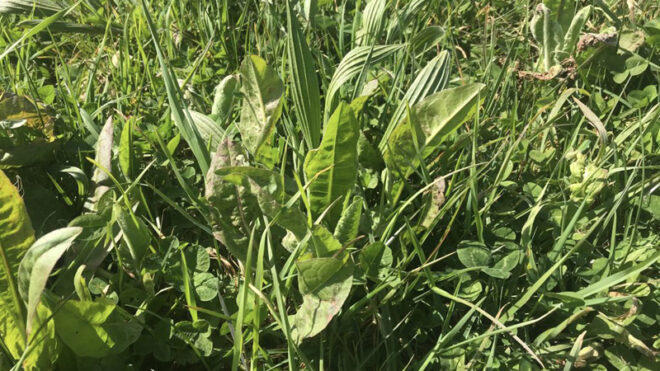Over the past 200 years farming has released carbon dioxide into the atmosphere, explains Tom Tolputt, mixed farmer and consultant. “Modern farming practices such as deep tillage, fertiliser and pesticide application release a lot of greenhouse gases. Nitrogen fertiliser production is very carbon dioxide heavy and a recent study has shown it actually burns carbon out of the soil.”
However, there are ways of building soil health and organic matter such as reducing tillage, changing grazing practices, introducing perennial species into arable rotations, and limiting the use of harmful chemicals.
If we can put 0.1% of organic matter back into the soil a year, this will sequester 8.9t/ha a year of carbon back into our soils.
“If we can put 0.1% of organic matter back into the soil a year, this will sequester 8.9t/ha a year of carbon back into our soils,” says Mr Tolputt. “Which also builds the ability to access and hold nutrients and will also improve soil biology and drought resistance.”
Step 1: Reduce tillage impact
Ploughing and deep tillage bring soil to the surface. “In this process carbon is released from the soil to the air and the environment for the mycorrhizal is destroyed.”
Reducing tillage keeps the mycorrhizal in place to function and mobilise phosphate to the plant. “If there is a need for ploughing in a rotation apply a mixture of molasses, mycorrhiza, trichoderma and bacteria as a spray on an established seedbed to encourage good biological activity in the soil. This will give the bacteria and fungi a food source to repopulate the soil and help the soil biology.”
A soil pit should be dug to establish compaction levels and then subsequently every three years to understand the impact of the reduction of tillage. “The move to reduced or zero till in conventional systems will help in preserving soil carbon.”
Step 2: Reduce bare soils
Growing cover crops or keeping a crop growing in the soil at all times keeps the soil biology alive. “It’s not a well-known fact but each plant pushes down 30-40% of the energy it photosynthesises in the form of root exudate – which is full of nutrients and feeds the soil biology. With bare ground the bacteria in the soil are not being fed, and so start to die off release carbon.”
Cover crops include; phacelia, alsike clover, daikon radish, oats, berseem clover, vetch and rye.
Step 3: Maximise diversity
The more diversity above the soil is relative to the number of ecosystems being fed in the soil.
“There are no monocultures in nature and different plants will support different bacteria in the soil – for example brassicas don’t support mycorrhiza in the soil very well, whereas oats or perennial crops do.
Also deep rooting crops like cocksfoot or chicory will push sugars and exudates further into the soil and support more ecosystems as well as sequestering carbon.
As a significant amount of a plant’s energy is returned back to the soil, this helps support the bacterial and fungal networks which then provide nutrients back to the plant; a form of symbiosis.”

A diverse ley will provide different levels of the soil with nutrients.
Step 4: Minimise detrimental practices
Detrimental practices including heavy cultivations, spraying fertiliser in high doses such as urea or ammonia – these should be avoided. Try to make sure the nitrogen used is slower release; nitrogen sulphate or combined with a source of humate or alternatively substituted for liquid applications. “The application of urea or harmful forms of nitrogen can effect on the soil carbon and bacteria.”
Step 5: Growing crops suitable to climate
Tailoring the rotation to the local climate means crops require fewer inputs to grow successfully, advises Mr Tolputt. “For example wheat is more suited to drier climates and fodder beat and oats are more suited to a costal environment.”
Step 6: Consider animals in the rotation
A more traditional rotation involves grazing animals on perennial crops. “These deep rooting crops help to build soil biology, soil nitrogen and sequester carbon – this reduces the amount of nitrogen required for the next crop.”
Holistic grazing, where animals are rotationally grazed and moved onto a new paddock every 24-72 hours, creates a symbiotic relationship in which the animals graze, digest and defecate – providing nutrients and bacteria back to the soil.
“The plants provide energy, through their root systems to the soil, the soil provides minerals to the plants and the plant provides food for the animal. The rest period allows time for the plants to regrow and improve their root system, allowing more carbon to be sequestered into the soil.”
Typical crops which could be included for a grazing ley are, cocksfoot, chicory, plantain, red and white clover and trefoil. “Including these mixes in grazing or cutting leys will increase drought tolerance and increase carbon sequestration within the soil, adding to a greater potential carbon benefit.”
